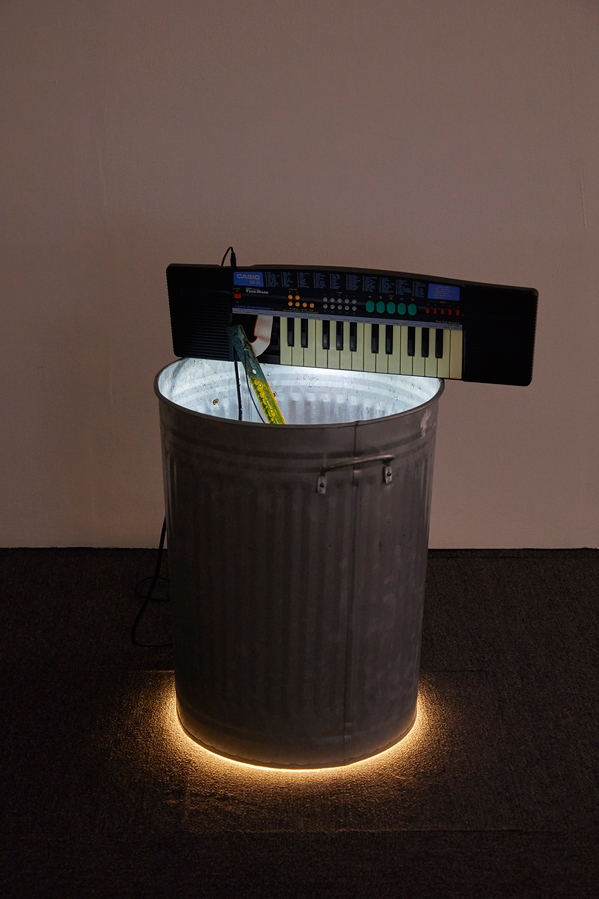Haroon Mirza develops concepts of coherence, idea-transmissibility and cross-connectivity at their most lateral; being unable to scan the QR code for this exhibition’s audio guide using my 2005 cell phone suggests that I might, in this respect, have to up my game. Mirza is known for tapping into LED lights to eavesdrop on their electrical workings: deprived of in-ear commentary, eavesdropping in the space seems the best alternative, which no doubt chimes with Mirza’s interest in fostering acoustical primacy in a culture he has called ‘ocularcentric’. An overheard rallying cry from students touring the show confirms Mirza’s point: “wow, look!” brought a group to peer into the LED-lit depths of a watery dustbin straddled by a mangled, water-triggered Casio SA-21 keyboard – just one element of An_Infinato (2009).
That work – as well as its antecedent, Taka Tak (2008), also here – emerges from an era that saw the term ‘circuit-bending’ popularised through Reed Ghazala and Nicolas Collins’s instructional tomes advocating the hacking of commercial electronic audio hardware as a means of creating divergent new sounds. The influence is apparent in five silent lightworks, from the LED Circuit Composition series (2015–18), resembling waveguide antennae wired with Lecher lines, intermingling dielectric yantras: their deceptive audio cable ‘outputs’ are actually mains power cable inputs for the LEDs. The circuit-bending ethos serves as a springboard: Mirza ‘bends’ culture, notably in Taka Tak’s combination of tensions pertaining to Islamic strictures, street cookery and audiovisual technologies, and in An_Infinato’s ‘appropriations’, wherein a 1970s Guy Sherwin film projection electro-optically triggers the aforementioned dustbin-water-keyboard while also shredding the soundtrack accompanying the ‘flocking bats’ scene in Jeremy Deller’s 2003 film Memory Bucket, shown on a neighbouring screen. The elementariness of the appropriations makes them effective building blocks, collectively representing ideas of influence on the artist.
Influence, a recurring theme, is also apparent in the inclusion of Channa Horwitz’s scores. A Chamber for Horwitz (2015) draws on her partial Sonakinatography I (1969) score, realised by Mirza as a sequenced colour composition powered by the gallery’s lighting circuit, with the buzzy 50Hz harmonics of his trademark sonified LED components. These expressions of influence reach their acme with Mirza’s Rules of Appropriation series (and related 2018 pieces) addressing intellectual-property theft by incorporating fake Louis Vuitton accessories within solar-powered electronic melodramas, some paradoxically sporting both copyright and open-source logos. These works are almost conceptual short-circuits: self-referential nuggets born of Louis Vuitton’s own (unsanctioned) derivations of Mirza’s work in a recent window display installed by the Acierta design company. They raise the question: at what combinatory point do elemental natural principles become intellectual property? A solar-charged smartphone embedded in Power to Instagram (2018) provocatively displays Acierta’s Instagram posting of the suspect exhibit. The tensions in this room culminate in Welcome to the Machine (2018); onto the screen showing an Osman Yousefzada film, documenting Bangladeshi sweatshop machinations, Mirza has taped a soundmaking circuit, functioning as a soundtrack for the film and heard through wireless headphones.
Other engagingly referential works are shown, spanning ten years of artistic practice, but it’s interesting to find The National Apavilion of Then and Now exhibited. Originally a sitespecific piece for the 2011 Venice Biennale, it consists of a bright halo of LEDs suspended from the ceiling of a triangular anechoic dark room with a mesh grille floor (‘No high heels’ warns the entrance sign). The floor is presumably from where the sound emerges: a swelling, phased buzzy hum derived directly from the LEDs’ electricity. A casual viewer may overlook its essential associations with the Biennale, but its sheer audiovisual thwack remains stunning, approaching Op art as the viewer experiences persistence of vision when the O-ring shuts off, leaving silent darkness and visual disorientation, invariably prompting gallerygoers to vocalise its shape: “oh!”
Haroon Mirza: reality is somehow what we expect it to be, Ikon, Birmingham, 30 November – 24 February 2019
From the March 2019 issue of ArtReview
